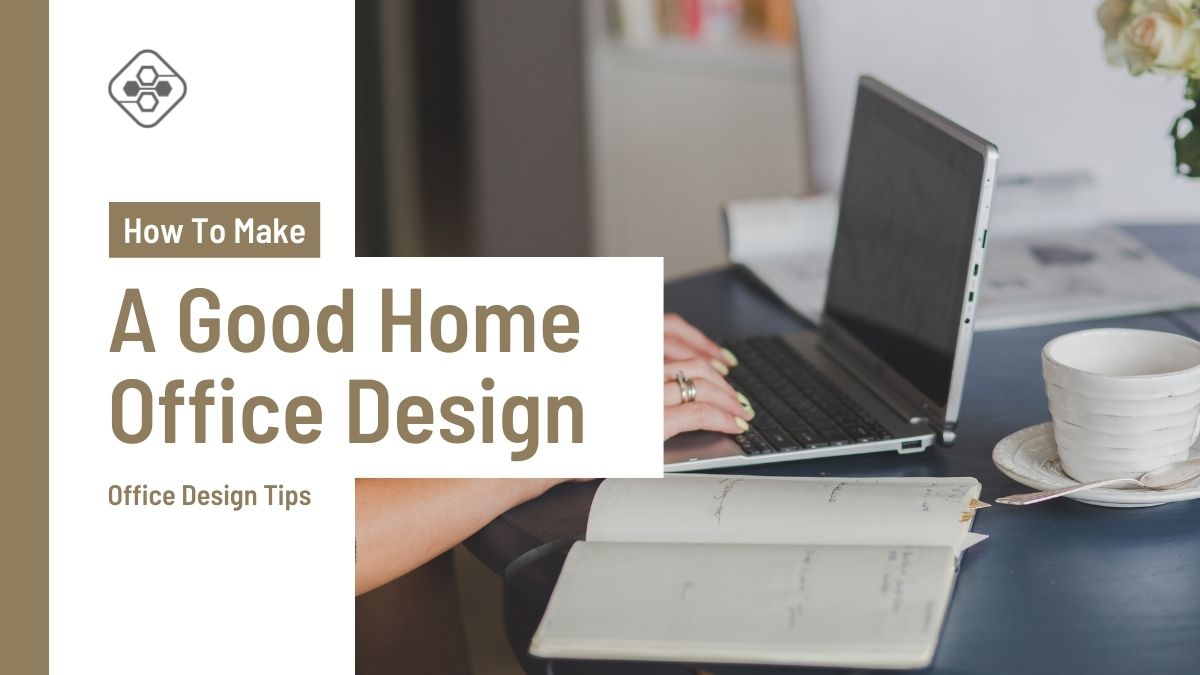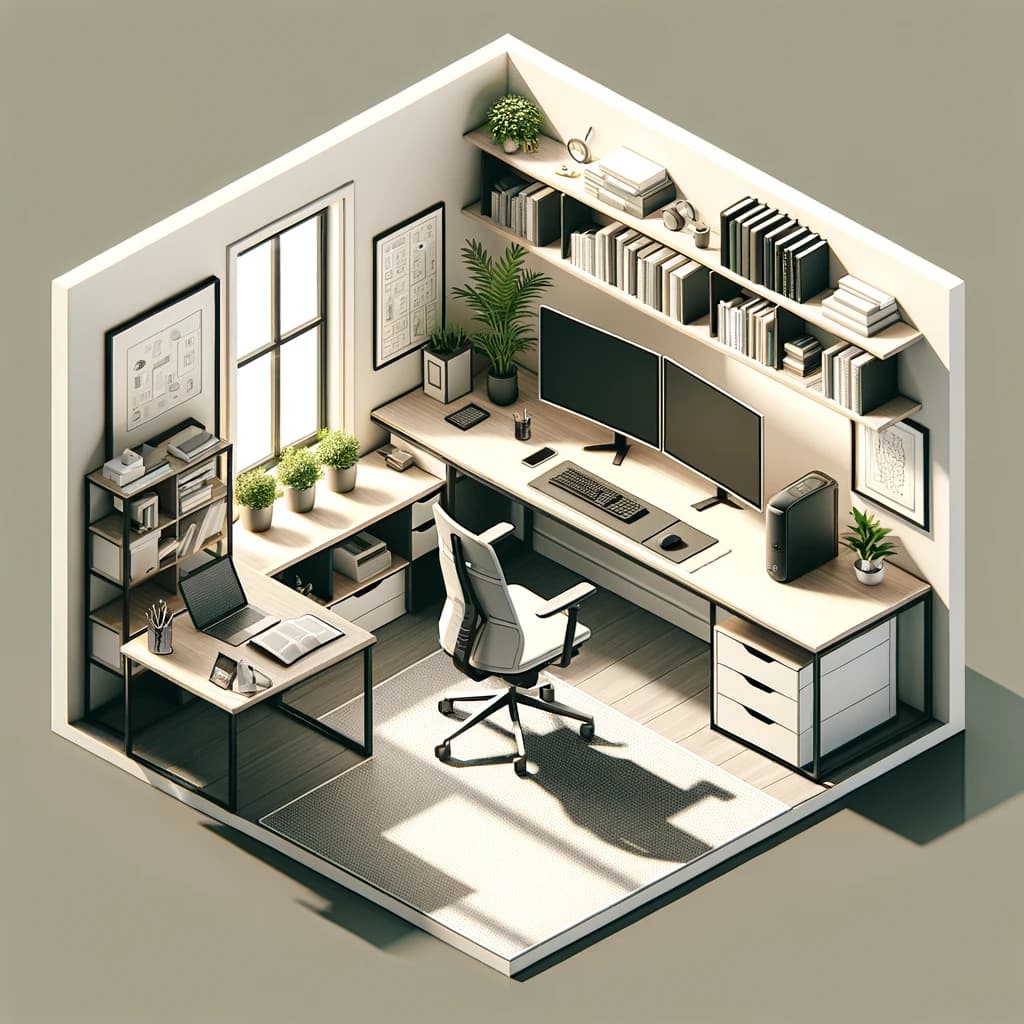Grow Your Business
The Average Size of Home Office: A Perfect Workspace

Are you curious about how large a home office should be? Crafting an ideal workspace within the confines of your home space might seem like a formidable task. However, with the rise in remote working initiatives, it has become more of a necessity to have a dedicated workspace within your home.
77% of remote employees say they’re more productive when working from home. With that, over 50% of employees globally work outside of their main office headquarters for at least 2.5 days a week. It’s vital to think about how your chosen furniture items fit with each other as well as how easy they are to put away after work hours.
When choosing furniture items, their dimensions should be a key factor in your decision-making process. By carefully planning and implementing a home workspace strategy, you can unlock your creativity and make home working a pleasure.
Interested in the average size of a home office? Stick around for an exploration of key considerations and rough estimates of space needed for a cozy home office.
Creating a Dedicated Workspace within your Home
Constantly shuffling items around in a non-dedicated workspace can be highly frustrating. You can circumvent this by setting up a specific area for remote work, this could either be an entire room or just a corner to place your desk and chair.
The benefits of a dedicated workspace at your home are numerous. It helps create a work-life balance as it draws a clear line between your personal space and workspace. It aids in keeping you organized and productive as everything you need for work is centralized in one place. It also supports mental well-being by introducing a stable routine. Last but not least, a dedicated workspace means you can have your private space free from distractions from household activities or family members.
Having your very own space to work in also lets you mentally separate work life from personal life, making it much easier to clock-out after work. The all-important question here would be – how much space do you need for your home office?

Understanding Average Office Size
There is no exact one size fits all when it comes to home offices. It varies from person to person. Some prefer to transform a spare bedroom into a workspace while some find a corridor desk or a bay window more comforting. This results in a wide range in the size of home offices today.
Home offices are designed in sizes ranging from a 50 square feet corner of a room to an entire 150 square feet guest bedroom. Before deciding on what furniture and organizing strategies to use, it’s crucial to scrutinize your space’s availability by measuring its dimensions.
The exact size of a home office will be subjective to each individual’s needs and the available space in the home. An ideal home office will typically have enough room to fit a desk, chair, and important office equipment like a computer, printer, or filing cabinet. It should also provide sufficient room for movement and good exposure to natural light by placing the work desk near a window.
The primary goal of a home office should be its functionality and comfort for the person working in it. As long as the space is comfortable to work in and equipped with everything needed for work, it is a suitable home office.
What if Your Home Lacks sufficient Space for a Home Office
In 2020, the average size of a home office was around 150 square feet (13.94 square meters). The ambition to materialize a business idea often overshadows adequate financial support, making home working a viable choice. However, that requires a sound workspace at home.
In case you lack a dedicated space in your home, there are alternatives. You can make use of a balcony, an adjoining hallway, or even two interconnecting rooms as a makeshift office.
Utilizing different sections of limited available space in your home is also a plausible solution. You can assign the primary office to house tools used most frequently, while the secondary office can store other equipment.
If there is a short supply of space for a dedicated home office setup, you can consider the following options:
- Utilize Spare Room. If there is a spare room that is not in use, you can convert it into a home office. This solution provides ample space and privacy, though it may not be feasible for everyone.
- Make Use of Corners. If there are corners or alcoves falling vacant, consider setting up a desk and chair to create a minimalistic yet functional home office.
- Transform Closet Space. An unused closet could double as a home office by setting up a small desk and chair inside. While it provides privacy, comfort could be an issue.
- Use Multifunctional Furniture. Furniture items with multiple utilities, like a fold-down desk or a wall-mounted table, can be a great solution. This approach allows you to have a workspace when needed and be tucked away at other times.
- Create Portable Workspace. If there is no spare room or corner, consider creating a portable office with a laptop and a comfortable chair. This setup can be relocated across the house as needed, letting you work in your comfort zone.
It’s all about being innovative with what you have at hand.
If your office is near stairs, you might consider designing a shortcut between the rooms through the landing. This space beneath the staircase can also be utilized as additional storage.

Boosting Light in Your Home Office
As it’s crucial to factor in lighting when mapping out your home office setup, especially when space is limited.
Remember, even in tighter workspaces, natural light remains a crucial ally. Here are five strategies for enhancing the light in your home office:
- Maximize Natural Light. Positioning your desk near a window optimizes natural sunlight, contributing not only to a well-lit workspace but also to your mood and productivity.
- Invest in Task Lighting. Alongside sunlight, consider additional task lighting, such as desk or floor lamps, to illuminate specific areas in your office.
- Embrace Light-Reflecting Paint. Light-colored walls help to bounce light around the room, effectively brightening the space.
- Install Mirrors. Mirrors can further exploit light, creating the illusion of a larger, brighter workspace.
- Consider Light Dimmers. A dimmer switch helps adjust the room’s lighting intensity according to your work demands. This can be useful when your schedule varies or when different tasks require different light levels.
Positioning your home office near a window ensures generous natural light, fostering a less restricted and more productive work environment.
For versatile desk lighting, an adjustable desk lamp might be a good investment. Its beam can be widened or narrowed according to your needs. Before choosing the lamp size, think about the necessary lighting intensity for your workspace.
Aside from utilizing natural light and standard lamps, neon signs offer an emerging technique. Personalize the text and graphics to your liking, selecting neon colors that complement your home decor for a chic touch. Neon signs also successfully blend the feel of home and work, enhancing your comfort while working.
Exploiting Extra Space in Your Home Office
Scratching out space for a home office is quite a puzzle. But fully utilizing that area once you’ve claimed it—now there’s a challenge.
Even if you’ve successfully etched out a small portion of your home for office use, awkward corners can still pose a problem. These often overlooked nooks, though seemingly tight and uninviting, actually hold uncapped potential.
Double It as a Guest Room
For many, converting a spare room into a combination of guest quarters and home office proves to be a practical solution, with the underused corner playing a vital role. It’s easy to dock a Murphy bed or modern daybed, which can neatly disappear when not needed, into the space vacated by your home office. This is particularly ideal if you have frequent weekend guests or if your extra room is big enough.
Create a Relaxation Zone
We get it — not everyone wants to devote their days to poring over paperwork. Sometimes, a warm chit-chat with a loved one is more inviting. Overlooked office nooks can serve as a peaceful respite for these moments. Accommodate more seating for your clients by adding a few comfortable chairs and a coffee table, creating a cozy conversation corner.
Design a Reading Corner
If you’re suffering from a bookcase backlog in your home office, why not transform that boring corner into a lavish reading retreat? All you need is a plush chair, a task light (or a sophisticated floor lamp), and a small shelf to showcase your book collection. Now, once the computer work is completed, the cozy corner awaits your presence for a relaxing reading session.
Consider it for Storage
When establishing a home office, storage often takes precedence over a desk and chair. Whether it’s a place to store data or simply some extra storage for stationary, every addition helps. Utilize corners wisely — wall-mounted cabinets conserve floor space, and corner shelves can be easily installed. In home offices, decorative add-ons such as open floating shelves in a corner can add both visual space and interest.
Bring in Some Greens
Placing an indoor plant in that vacant corner might feel too simple, even insignificant. But have you ever thought of livening up your home office with a bit of greenery? Besides being aesthetically pleasing, plants can prolong your life, enhancing your health and happiness by clearing harmful chemicals from your office air. Never underestimate the potential productivity benefits nature can bring to your workspace.
Don’t set up shop in the living room or kitchen. These spaces are commonly used right after work (making it harder to switch gears from work to home), and, as common areas, they are rife with distractions, especially in shared residences.
Having a dedicated space to shut the door and leave your work worries behind is essential if you work from home.
Closed-off rooms are preferable, but not everyone has access to them. If that’s the case, consider all the spare rooms you have that may be converted into offices. No huge room is needed to house your home office, provided you use your imagination.
Choosing the Right Desk for Your Home Office
The cornerstone of any productive home office is a well-chosen desk. Your chosen desk should accommodate both your computer or laptop, and also allow ample room for your legs. The chair you’ll be using is another crucial factor to factor in while selecting your desk.
The perfect desk height for a home office generally falls between 29 to 30 inches, leaving plenty of flexible workspace. Given that many people are now accustomed to a remote workflow, which often involves packing away work items at day’s end and primarily using portable tech like laptops or tablets, it’s not absolutely necessary for your desk to be overly spacious.
Investment in a height-adjustable desk can better leverage your usable space. Don’t limit yourself to traditional desks, consider options such as laptop desks, console desks, collapsible workstations, or L-shaped corner desks, which can offer more flexibility. Height adjustable desks, particularly electric ones, are becoming increasingly popular due to the greater convenience and reduced physical requirement, a common preference in Scandinavian countries known for their employee-focussed ethos.
Start by assessing your space requirements for your keyboard, mouse, laptop, and landline phone. Then, establish how much room you’ll need for any extra hardware and ensure there’s enough space to conveniently open a binder, jot some notes, etc.
Picking the Perfect Chair for Your Home Office
The first point of order? Ensuring your office sports a premium-quality chair. Balancing the scales between an appealing aesthetic and functional comfort can be a tricky business. You certainly don’t want to settle for an eye-catching seat with zero ergonomic benefits, or an oversize, unwieldy office chair, as comforting as they may be for your posture. A smart chair is a convergence of stylish design and sturdy framework.
Consider your seat requirements in relation to how you plan to use the office room. Do you need the freedom to roll about the room, or will you be more relaxed with your feet propped up? Identifying your top priorities could help you to determine how much room you can spare for a desk and chair.
A well-sized ergonomic chair for your home office should provide a seat deep enough that the user can lean against the backrest without causing pressure to the backs of their knees while maintaining a gap of two to four inches.
It’s necessary to adjust your office chair to fit your personal dimensions (height, weight). In a typical office setting, there should be about 10 to 12 inches of clearance between your desk and chair. The ideal chairs will help the user to seamlessly move in all directions: forwards, backwards, laterally, and vertically.
This type of stationary activity is known as “active sitting.” As you learn to master active sitting, your core muscles will strengthen, and you’ll notice an immediate improvement in your posture, joint mobility, focus and concentration.
Creating a Pleasant Home Office
Your home office should ultimately be a place you look forward to being in. You can cultivate a cosier, more inviting space by infusing your personal touch into the office’s décor. One easy way to brighten up your work area is with greenery.
Incorporate intimate and memorable elements into your home office decoration. Items such as photographs of loved ones, blown-up prints of your favourite video game, or pieces of art you’ve created can all provide the perfect balance between a functional workspace and a personal haven.
Maximizing the Perception of Space Your Office
Born out of necessity, you may have had to get creative and employ a few tricks to give the impression of a larger home office space.
When decorating your office, consider using low-bearing furniture. Doing so creates an illusion of taller ceilings and additional floor space. Modernist, low-bearing furniture is particularly effective as it doesn’t obstruct natural light sources, which notably expands the perception of available space in a room.
To further enhance the feeling of spaciousness, consider matching molding your wall,, and ceiling creating colors monochromatic effect. By a, the visual flow from paint to molding is smooth and can lengthen the room, giving an illusion of higher ceilings and a larger square footage.
Investing in a Home Office – What’s the Price Tag?
This is a frequently asked question by remote workers, especially in recent years where global events like the Coronavirus pandemic and the conflict in Ukraine have had a dramatic impact on inflation. It’s a common sight to be taken aback by the escalated price tags on items during our shopping excursions. However, setting up a home office can entail valuable deductions from your income tax return, while also cutting out regular commuting costs.
Therefore, it may be a wise idea to consider spending a little extra on it.
Standing essentials for a home office set up typically involve a desk, computer, and chair. You’ll also need certain tech provisions like internet access, software subscriptions, etc. The cost of these requirements can vary depending on factors like the material quality and manufacturing company.
With some enthusiasm and ingenuity, you can set up a functional office for next to nothing or at most $500. However, if you’re considering getting extra accoutrements, your budget may stretch anywhere from $2,000 to $6,000. The decision ultimately lies with what’s most suitable for your personal needs and the state of your wallet.
Laying Down the Ground Rules
Living in a shared space with roommates, spouses, or children calls for clearly defined rules regarding when and where work hours are to take place. Make it clear to them when they can expect you to be in “off work” mode and when it’s important for them not to interrupt your work time.
Establishing these ground rules upfront will significantly contribute to maintaining productivity and promoting a healthy work/life balance, even though it might initially be challenging, particularly with little ones around.
Remembering to Take Breaks
Success in any venture calls for periodic breaks from work to relax and rejuvenate, allowing you to re-engage with your tasks with renewed passion and energy. When working from home, you need to be even more conscious about scheduling break times compared to a traditional office atmosphere.
schedule your breaks according to the time or the milestones you’ve achieved. Even a few-minute break from time to time throughout the day can significantly help maintain your energy and productivity levels.
Adding a Personal Touch to Your Home Office Setup
Giving your workspace a touch of your personality can make it feel more your own, considering the substantial amount of time you’ll be spending there. Personal trinkets such as photographs, artwork, and souvenirs can not only reflect your personality but also make your home office feel less like shared space and more exclusively yours.
Showcase your accomplishments and accolades. Infusing your workspace with significant objects, family photos, and cherished memorabilia can make your home office a genuine reflection of you.
While it’s gratifying to incorporate personal and creative elements in your workspace, be careful not to go overboard as it may clutter your workspace and cause distractions.
Conclusion
A survey found that 74% of professionals expect remote work to become a business standard. Having absorbed the insights from this article, you’re now equipped to determine the ideal square footage for a home office that fulfils your needs. Your workspace can be structured and sectioned based on necessity. The measurements discussed throughout this article will enable you to establish the optimal home office setting for your work-from-home needs.
-

 Manage Your Business2 days ago
Manage Your Business2 days agoTOP 10 VoIP providers for Small Business in 2024
-

 Cyber Risk Management6 days ago
Cyber Risk Management6 days agoHow Much Does a Hosting Server Cost Per User for an App?
-

 Outsourcing Development6 days ago
Outsourcing Development6 days agoAll you need to know about Offshore Staff Augmentation
-

 Software Development6 days ago
Software Development6 days agoThings to consider before starting a Retail Software Development
-
Edtech2 days ago
How to fix PII_EMAIL_788859F71F6238F53EA2 Error
-
Solution Review5 days ago
Top 10 Best Fake ID Websites [OnlyFake?]
-
Business Imprint6 days ago
How Gaming Technologies are Transforming the Entertainment Industry
-

 Gaming Technologies4 days ago
Gaming Technologies4 days agoHow to Set Up Text-to-Speech for Channel Points on Twitch









